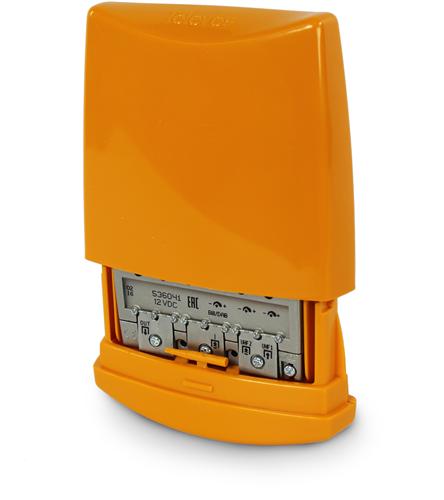“There Ain’t No Such Thing As A Free Lunch.” —Robert A. Heinlein
That simple axiom, often abbreviated TANSTAAFL, is pretty central to the way that all RF devices work. No matter if it’s an antenna, satellite, cell booster, or something else, you can’t get something from nothing. It may seem like you’re plucking a signal out of thin air, but a TV station spent hundreds of thousands of dollars on electricity so you could. In order to pay for that, the TV station has to sell commercials. No matter what you do, someone pays for it somewhere down the line.
So, it might surprise you that a part like this line amplifier doesn’t need to be plugged in. It improves signal strength, but you know it can’t do that without power because, TANSTAAFL. What’s the deal then?
You actually do see unpowered accessories like amplifiers and multiswitches all the time in satellite TV. Even the dish itself has amplifiers built in, and there’s a simple answer: of course there’s power. You just don’t see it.
With any satellite system, even the simplest one, current flows up the coaxial cable to power the dish and other devices. A typical satellite system will put more current on the line than the dish needs. Other devices can mooch off this current if need be. The excess current doesn’t hurt the dish if it does get up there, and it’s designed to compensate for long cable runs (which sap power.)
Do the math
A typical old-school satellite system needs a minimum of about 22 watts to work. A typical satellite system puts out as much as 29 watts over the coax line. That means if your cable run is short and your equipment is efficient, you have some watts to play with. This line-powered amplifer uses about one watt typically. So even with it in the middle of everything, you probably have enough power that you don’t have to worry about it.
Is “probably” enough?
Generally you’re not putting in an amplifier unless you need it, and that’s why I say if you’re going to amplify your signal then you should use powered amplifiers. That means every possible bit of current can go to power the dish. Instead of that amplifier I pointed out in the last paragraph, use the powered version. It’s more expensive but if you do need an amplifier, you probably need all the current you can get at the dish. Note that yes, the manufacturer’s product name does say that this is a SWM amplifier. Truth is, it’s not and please don’t use it that way.

If you’re using a Televes mast-mounted amplifier, it’s actually designed with plenty of extra current so that you can power other Televes devices inline. The power injector that sits inside will power not only this amplifier, but also the amplifier at the antenna and there’s actually more headroom left for a third amplifier if needed, although you wouldn’t really need a third amp unless you’re talking about wiring an entire apartment building. That’s what they do in Europe where these amplifiers are made.
It’s not magic…
So you see it is possible to have an unpowered amplifier that works without magic, but it’s also important to think about the downside to where that power comes from. If the system isn’t designed to provide plenty of power for unpowered accessories, it is probably better to use their powered equivalent.
If you’d like to know more, call the antenna experts at Solid Signal. We’re here during East Coast business hours. The number is 888-233-7563. If it’s after hours, just fill out the form below!
The post How can you have an “unpowered amplifier?” appeared first on The Solid Signal Blog.
Continue reading...

